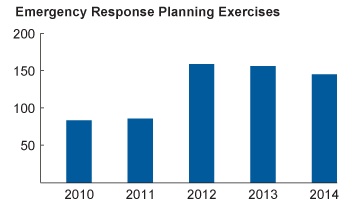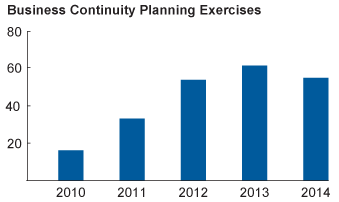Managing Risks

Liwan
Purpose and Progress
Risk management and mitigation practices are embedded in strategic planning and operational processes. Identifying risks, measuring competency, training personnel and purchasing equipment are guided by Company policies, standards, processes and best practices.
Enterprise Risk Management
The Enterprise Risk Management (ERM) program identifies and assesses potential hazards and risks that could impact the health and safety of people, property and the environment.
The Corporate Risk Management group undertakes a major review of the Company’s risk and mitigation activities each year to better identify and manage risk, understand the risk-drivers and promote a culture of risk awareness. The review determines who is accountable for managing and mitigating each risk and identifies any emerging issues.
Emergency Preparedness
Readiness for potential emergencies is strengthened through exercises, established processes and Emergency Response Plans (ERPs) designed to guide a consistent and effective response to any event which could affect employees, contractors, the community, the environment and/or the Company’s assets and reputation.
Husky’s procedures are based on the Incident Command System (ICS), a standard emergency response model used across Canada and the U.S. to provide an effective response across all operations. This system streamlines the response so that the most important action items are addressed in priority order and under clear accountabilities.
Regular cross-departmental exercises, and consistent, repeatable processes are an integral part of being prepared for, and improving the response to, an emergency. Where appropriate, coordination with third-party emergency responders is tested in major exercises.
Site-specific planning, equipment upgrades and training enhance readiness for facilities where there is the potential for higher-consequence events.
The Company participates in additional training as an active member of spill cooperatives and preparedness programs. It is a member of Emergency Response Assistance Canada, which provides response plans for the transportation of dangerous goods. Husky has Transport Canada-approved Emergency Response Assistance Plans for flammable materials shipped by rail or road.

Business Continuity
Husky develops contingency plans and measures to mitigate the impacts should a business-interrupting event occur.
Response strategies for individual departments are documented and tested to ensure the business continues to operate during an event. Awareness sessions educate employees on their responsibilities, while each year exercises test the capabilities of the Company’s continuity plans, often with multiple departments participating together.

HSE Policy
Husky is committed to operational integrity. Operational integrity at Husky means conducting all activities safely and reliably so that the public is protected, impact to the environment is minimized, the health and well-being of employees is safeguarded, contractors and customers are safe, and physical assets (such as facilities and equipment) are protected from damage or loss.
The Company conducts its business so as to maximize positive impacts on current and future generations in accordance with its values, while minimizing the use of non-renewable resources. In particular, Husky will:
- Demonstrate leadership and commitment to operational integrity by providing support to meet this HSE policy, as well as providing a culture where there is recognition for positive performance and disciplinary action, where appropriate, for breaches of this policy.
- Require every member of staff, and those who work on our behalf: to be a leader in HSE; to exercise personal responsibility in preventing harm to themselves, to others, to the environment and to physical assets and to stop any work that is or becomes unsafe.
- Require every member of staff and those who work on our behalf: to report all incidents regardless of severity. Incidents will be investigated to determine the root cause, lessons learned will be shared and corrective actions will be taken. Husky aims to sustain an incident-free workplace.
- Identify and mitigate risk to as low as reasonably practicable during design, construction, commissioning, operation and decommissioning of all assets.
- Prepare for and respond to emergencies efficiently and effectively.
- Comply with relevant laws, regulations and industry standards and take any additional measures considered necessary to meet the intent of this policy.
- Demonstrate continuous improvement by: establishing leading and lagging key performance indicators and measurable performance goals, monitoring and reporting on the progress of our performance and conducting risk-based audits.
Code of Business Conduct
In accordance with the Company’s Code of Business Conduct, Husky’s employees are expected to conduct themselves in an ethical manner, with a high degree of personal integrity. Employees take mandatory training so that they are aware of their responsibilities.
The Company has established a confidential and anonymous Ethics Help Line where employees, contractors and other stakeholders can report perceived breaches of the code of conduct.
Ethics Help Line
The Ethics Help Line is managed by EthicsPoint, an independent service provider. Callers can choose to provide information anonymously. Information from submissions is captured and submitted to an Ethics Help Line Committee, which includes representatives from the legal, audit, security, health, safety, environment and human resources departments.
